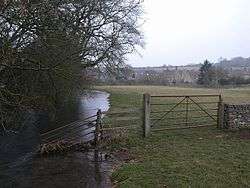River Churn
The River Churn is the first tributary river of the River Thames. Approximately 25 kilometres (16 mi) in length, it rises in the Cotswolds at Seven Springs, England and flows south, joining the Thames in Cricklade. Its length from source to confluence with the Thames is greater than that of the Thames from Thames Head, though the Churn is regarded as a tributary historically and therefore by most geography guides.
| River Churn | |
|---|---|
 River Churn near Baunton | |
| Location | |
| Country | England |
| Counties | Gloucestershire, Wiltshire |
| Towns | Cirencester, Cricklade |
| Physical characteristics | |
| Source | |
| • location | Seven Springs |
| • coordinates | 51.8511°N 2.0504°W |
| • elevation | 200 m (660 ft) |
| Mouth | River Thames |
• location | Cricklade, Wiltshire |
• coordinates | 51.6450°N 1.8533°W |
• elevation | 79 m (259 ft) |
| Length | 25 km (16 mi) |
| Discharge | |
| • location | Cerney Wick, South Cerney |
| • average | 0.86 m3/s (30 cu ft/s) |
| • minimum | 0.00 m3/s (0 cu ft/s)5 November 1995 |
| • maximum | 4.70 m3/s (166 cu ft/s)31 January 1971 |
| Discharge | |
| • location | Cirencester |
| • average | 0.77 m3/s (27 cu ft/s) |
| Discharge | |
| • location | Perrott's Brook |
| • average | 0.62 m3/s (22 cu ft/s) |
| Basin features | |
| River system | River Thames |
Description
The River Churn is the first tributary river of the River Thames. It rises in the Cotswolds at Seven Springs near Cheltenham, Gloucestershire, England and flows south across the Cotswold dip slope, passing through Cirencester and joining the Thames in the parish of Cricklade in Wiltshire. Its length from source to confluence with the Thames is considerably greater than that of the Thames from Thames Head; its flow is also more consistent than the winterbourne Thames, but the Churn is regarded as a tributary historically and therefore by most geography guides. The length of the Churn is approximately 25 kilometres (16 mi). It is classed as a main river and thus falls under the jurisdiction of the Environment Agency as opposed to the local authority.[1]
Etymology
The name Churn is ancient, certainly pre-Roman and probably from a Celtic language, possibly that spoken by the Dobunni tribe who controlled the area before the Roman conquest in the 1st century. The original name may have sounded similar to Korinn. It has also been suggested that the origin of the word is associated with the ancient British Cornovii tribe.[2] Cognate names and name elements from the area are Cerney, Ciren and Corin as found in the settlement names of North Cerney, Cirencester, South Cerney, and Cerney Wick (all on or close to the river). Cirencester's original recorded name of Corinium Dobunnorum also shares this root.
History
- Much of the catchment basin of the Churn was a key Roman settlement in the second to fourth centuries AD, as Corinium Dobunnorum rose to likely status of capital of a division of Britain.[3]
- The Churn and the Thames feed the waters of a western bisection of the Cotswold Water Park, converted since the 1970s from redundant gravel beds between Cirencester and Cricklade.
- In 2006, the national government was engaged in a planning study to analyse methods of mitigating future flooding associated with the Churn.[4] However, the river is known to stop flowing completely at times; in September 2011 the river bed was completely dry at Latton.
References
- "River Churn Crossing and Data". Archived from the original on 5 April 2007. Retrieved 9 September 2019.
- "Cirencester History Summary". Cirencester.co.uk. Retrieved 9 September 2019.
- Wacher, John (1995). The Towns of Roman Britain. London: B T Batsford.
- "United Kingdom Environment Agency River Churn Catchment, Autumn, 2006". Archived from the original on 11 January 2007. Retrieved 15 January 2007.
External links
![]()
| Next confluence upstream | River Thames | Next confluence downstream |
| - | River Churn | River Key (south) |